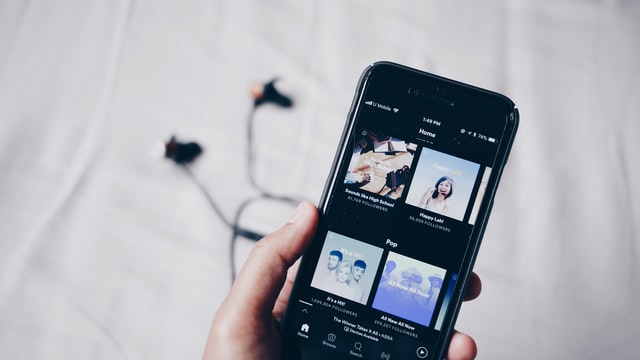
Adele’s long awaited, newly released fourth studio album, 30 was guaranteed to make waves in the international music scene as Adele’s first full-length record in over six years. This week it made the news for a different reason.
In response to Adele’s request, Spotify has hidden the shuffle button from all albums accessed via the streaming music platform. In a viral tweet immediately following the release of “30”, Adele commented “We don’t create albums with so much care and thought into our track listing for no reason… our art tells a story and our stories should be listened to as we intended. Thank you Spotify for listening.”
To which Spotify’s official Twitter account responded, “Anything for you.”
The move is likely to be well-received by Adele’s popstar peers, such as Lady Gaga who implored the public listen to her album Chromatica start to finish when it released in 2020.
Shuffle away
Spotify’s shuffle button randomises songs. It is neither new nor unique. In the early 1980s, shuffle was available on CD players and MP3 players. It served as a staple for Spotify’s largest competitor Apple, via iTunes and long-forgotten devices such as the iPod and iPod shuffle.
Shuffle is essentially a random number generator that picks the next songs based on chance. The problem is true randomness means the same song might sometimes play repeatedly. In 2014, Spotify tweaked their algorithm to make shuffle seem more random.
Shuffle is still available on Spotify for playlists, but users must now access it via a menu when listening to albums as opposed to having the option right next to the play button. A statement from Spotify hailed their “new premium feature […] to make play the default button on all albums”. This change applies to all albums, not just Adele’s 30, and features on both mobile and desktop versions of Spotify.
Spotify has faced dissatisfaction and criticism from musicians who decry the appalling low streaming payout rates to artists, and academics who raise concerns over the platform’s lack of transparency around data.
But Spotify has rarely changed course in response to critique – yet Spotify willingly removed the feature from album pages upon Adele’s request to preserve the continuity of her album – a sign of the artist’s immense clout.
The album is not dead
Spotify’s decision to hide the shuffle button contrasts accusations that Spotify is responsible for “killing” the musical album as we once knew it.
As the largest music streaming service by paid subscription, Spotify is a powerful force in the global music industry. Artists, labels and production companies have taken note from Spotify as to what works and doesn’t work on a music streaming platform.
Though revenues from streaming are far lower than purchases or individual downloads, superstar artists like Drake have taken advantage of streaming services to garner billions of streams that pay out millions of dollars in revenue.
Even so, the numbers are underwhelming for mid-tier and independent artists. According to Digital Music News a niche EDM artist who managed the impressive feat of having listeners stream their music one million times over four months only generated about US$5,000 (A$6,924) in 2013.
One important issue is curated playlists. Much like radio stations, Spotify features playlists of the top charting songs in various regions, but unlike radio stations Spotify has a vast library of playlists to match every genre, mood, and moment handpicked by curators or created and shared by other users.
Producing “playlistable” songs that are more likely to be placed on a popular genre or mood playlist is now a crucial strategy to build a following, attract labels and earn a living in music – but doing so comes at a cost. Orphan songs separated on a playlist from their album will not be experienced as part of a story in the context as artists like Adele intended.
The imperative to create popular singles is not new, the music industry is and has been centred around the hits, but the shifting logic of digital music streaming puts pressure on artists to examine carefully the cost and benefits of creating longer form art.
Beginning in 2014, Billboard started calculating album equivalent units, or the number of streams that would count as one album sale when determining an album’s position on Billboard Charts. Having more songs on an album means more streams, which could translate to a higher chart position. It also means more money.
Artists have released longer albums, such as Kanye West’s recent album Donda (Deluxe) with a track listing topping 30 songs. This strategy could be seen to lead to more padding and fewer hits, ultimately diluting powerful records with bland or forgettable tunes, “as if artists are curating playlists rather than crafting cohesive projects”, according to this VICE article.
Adele’s insistence on the importance of streaming the twelve tracks on 30 in their proper order, and Spotify’s capitulation to her request, will resonate with artists who have been urged by labels, publishers, or the industry writ large to create “playlistable” singles or lengthier albums.
Long live the album
The death of the album has been forecast for over a decade and streaming services like Spotify have been one of the many potential culprits blamed. Yet artists are still releasing full, artistically realised albums in 2021.
In 2015, I released an album with my band on streaming services including Spotify and Apple. My band-mates and I experienced firsthand the time and expenses needed to produce a full-length original album. We agonised over the track listing and waited until the full album was finished before we released any of our songs.
Six years later, I fully agree with Adele. I prefer to listen to my album in its intended order and I hope others will too. Like me, the average artist lacks Adele’s persuasive influence to change the design of a major music streaming platform in order to tell a more cohesive musical story.
But that’s exactly what Adele and Spotify have done. Now you are encouraged to stream 30 by Adele in the order the artist intended.
By:
Assistant researcher, Queensland University of Technology
Disclosure statement
D. Bondy Valdovinos Kaye is the drummer and co-songwriter for Parallel Path.
This post was originally published at The Conversation.




